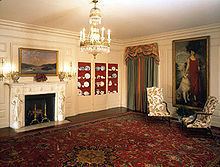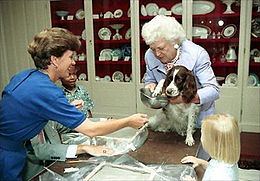 | ||
The China Room is one of the rooms on the Ground Floor of the White House, the home of the President of the United States. The White House's collection of state china is displayed there. The collection ranges from George Washington's Chinese export china to Bill Clinton's ivory, yellow, and burnished gold china. The room is primarily used by the first lady for teas, meetings, and smaller receptions.
Contents
- McKim refinishing
- The china collection begins
- Truman and Kennedy periods
- Nixon redecoration
- China collection
- Furnishings
- References

McKim refinishing

Until late 1902 when the room was refinished as a public entertainment space during renovations directed by Charles Follen McKim, this room, along with most of the ground floor of the residence, was used for household work and general storage. McKim rebuilt the room with details from the late Georgian period including robust cove moldings.
The china collection begins

After becoming first lady in 1889, china painting enthusiast Mrs. Benjamin [Caroline Lavinia Scott] Harrison (1832–1892) began to gather and restore china from previous administrations, which she eventually arranged within the mansion's private Family Dining Room. Harrison successor Mrs. Theodore [Edith Kermit Carow] Roosevelt (1861–1948) celebrated the then newly initiated efforts of journalist Abby Gunn Baker (1860–1923) to research the growing collection, allowing her to both expand and arrange the collection in Arts and Crafts Movement cabinets in the semi-public ground floor corridor - a space newly defined as a gallery during the 1902 McKim, Mead, and White renovation of the White House. This relocation of the china collection represented a burgeoning recognition of and appreciation for the historic artifacts associated with the American Presidency. (Damaged china had been sold or given away as late as the McKinley administration.)

In 1917, First Lady Edith Bolling Wilson acknowledged the need for more space for displaying the collection through the suggestions of both Mrs. Baker and White House Chief-Usher Irwin Hood ["Ike"] Hoover (1871–1933). Baker had continued to research the history of the mansion—and particularly that of its celebrated tableware—and argued that the history of the house would slip away without official intervention. In response, Mrs. Wilson surveyed the Ground Floor with Hoover, designating a large room located towards the southeast, next to the oval Diplomatic Reception Room, as the new "Presidential Collections Room." She also approved its outfitting with built-in cabinetry for the display of the china. Above each of the three bays of built-in wall cabinets was raised lettering identifying the holdings as CHINA USED BY THE PRESIDENTS.
Truman and Kennedy periods

During the Truman renovation, 1948–1952, the room's walls were paneled in salvaged pine timbers from the house. Architect William Adams Delano detailed the room with bracket molding of mid-Georgian style. (Unfortunately, the architect did not replicate the depth of the removed Wilson-era cabinets, preventing the inclusion of an important standing punchbowl from the Pierce administration—restored by Mrs. Harrison—in the reconstructed interior; the piece was subsequently displayed in the window of the room.) The Truman-era paneling was left unpainted until the Kennedy administration, when, in 1963, French interior designer Stéphane Boudin (1888–1967) of the Paris-based firm Maison Jansen, had it glazed in three shades of gray, with white detailing; corner brackets included in the display cabinet doors were removed at this time. The interiors of the display cabinets were lined with red cotton velvet, and the floor was covered with a similarly hued "Snowflake"-pattern carpet manufactured by Stark Carpet Corporation. At the single window, gray velvet draperies, trimmed in red and white silk fringe, were installed. An early-19th century classical marble mantel with female supports replaced the Truman Georgian surround.
Nixon redecoration

The room was substantially redecorated in 1970 by First Lady Pat Nixon, with the assistance of White House Curator Clement Conger and preservation architect Edward Vason Jones. The Truman-era bracketed molding was removed and replaced with a Federal period cove molding. The walls were painted a uniform off-white. The existing red accent color, determined by the red gown in Howard Chandler Christy's 1924 portrait of First Lady Grace Coolidge, was retained. The vitrine shelves remained lined with red velvet.
China collection
The collection is arranged chronologically beginning to the right of the fireplace on the east wall. While not every administration created its own service, at least minimal amounts of all china services created for the White House are now in the collection. Sizable amounts of some services going back to the early nineteenth century exist and are sometimes used for small dinners in the President's Dining Room on the Second Floor. The Carters favored using pieces of the Lincolns' "solferino" (purple-rimmed) china for special occasions. The Reagans, though famous for their red and gold service, also enjoyed using the Lincoln china. The Clintons did not take delivery of their state service until near the end of President Clinton's second term. They used the Reagan and Truman services extensively for state dinners, but for small family dinners, especially holidays, favored the Hayes china which depicts American flora and fauna.
Furnishings
The rug is an Indo-Ispahan carpet from the early twentieth century. A cut-glass Regency-style chandelier hangs in the China Room. A pair of late eighteenth century tureens on the mantel are glazed in red and green slip, and are the source for the green and red striped silk taffeta draperies. Two high-backed lolling chairs, made early in the nineteenth century and upholstered in ivory and moss green, are arranged in front of the portrait of Mrs. Coolidge. An English neoclassical mantel is located on the east wall, and Ferdinand Richardt's "View on the Mississippi Fifty-Seven Miles Below St. Anthony Falls, Minneapolis", completed in 1858, hangs above the mantel.
